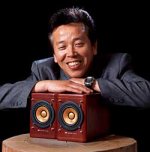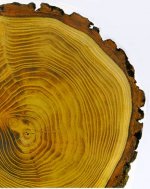5th element said:Not to be a killjoy but surely all paper cones are wood......
What about hemp, rice, banana pulp (Fostex), and other fibres paper are made of? Wood pulp paper is an artifact of the US making hemp of all kinds illegal (primamrily so that Dupont could make a profit on Nylon)
dave
More pics of the wooden cones:
Here's how the speaker's wood cones are manufactured.
An externally hosted image should be here but it was not working when we last tested it.
An externally hosted image should be here but it was not working when we last tested it.
Here's how the speaker's wood cones are manufactured.
how about a new hi-tech material:
cellulose-reinforced lignin! oh wait. thats wood too. nevermind! 🙂
cellulose-reinforced lignin! oh wait. thats wood too. nevermind! 🙂
So, what kind of stores are we going to see this thing in? It looks like it is definitely targeted towards the high end. $8,000, maybe? I wonder if we also get a wood coned powered subwoofer. One concern is, how does the grain of the wood affect the way the cone breaks up (folding at high accelerations)? While wood cones have a very expensive and distinctive look to them, I suspect they're far from a perfect cone material.
Addendum:
Apparently, this new-fangled mini hi fi system will retail for $550. It looks a lot more expensive than that, though. Now we just need a good subwoofer as well.
Addendum:
Apparently, this new-fangled mini hi fi system will retail for $550. It looks a lot more expensive than that, though. Now we just need a good subwoofer as well.
Judging by the cutouts in Fig 2 of post #10, these cones are cut as a straight cone, no curvilinear shape to them at all. Most speaker cones "open up" as they approach the surround.
I wonder if that is good. Why would other cone materials be intentionally given a curvilinear shape unless it provided an advantage over the straight cone?
I wonder if that is good. Why would other cone materials be intentionally given a curvilinear shape unless it provided an advantage over the straight cone?
kelticwizard said:Most speaker cones "open up" as they approach the surround.
In my survey of drivers it seems about 50/50 straight/curvelinear. Often straight cones will have annular rings thou.
dave
planet10 said:What about hemp, rice, banana pulp (Fostex), and other fibres paper are made of? Wood pulp paper is an artifact of the US making hemp of all kinds illegal (primamrily so that Dupont could make a profit on Nylon)
I've heard that DuPont conspiracy before but have never seen any credible evidence to support it. Isn't it strange that state and local governments were prohibiting marijuana as well as hysterical anti-marijuana propaganda being produced (largely aimed at blacks and Mexicans) well before DuPont ever developed Nylon?
se
I suspect they're far from a perfect cone material.
I agree, Wood may be a good idea but there might be huge problems with consistency.
"Sorry but our wood cone woofer is not so good this year because we had a lot of rain. But next year, if the weather is good, we hope to have that smooth response back."
Often straight cones will have annular rings thou.
I have an idea, make a wood cone taking advantage of the wood natural built-in annular rings...
Attachments
Only prob with that is crossgrain veneers have very little inherent strength...
I think if I was looking at making a serious wood cone, I'd laminate at least two extremely thin normal veneers at 90 deg. grain orientation, or three at 120.
I think if I was looking at making a serious wood cone, I'd laminate at least two extremely thin normal veneers at 90 deg. grain orientation, or three at 120.
Sorry for waking a long dead thread but are there wooden cone drivers aside from the JVC mini systems?
Has anybody heard these wooden cone drivers or the JVC systems?I seen the release 2 years ago and was wondering if anything had come about?
It would seem wood would be able to avoid the cone breakup of paper no?
Has anybody heard these wooden cone drivers or the JVC systems?I seen the release 2 years ago and was wondering if anything had come about?
It would seem wood would be able to avoid the cone breakup of paper no?
What is the Fuzz about wood cone? Can anyone tell me what the advantage of using a wood cone speaker compares to paper cone?
I hope my question is not too foolish 🙂
I hope my question is not too foolish 🙂
I can't see any advantage other than marketing. Solid wood has two disadvantages: Consistency and durability.
Consistency: No matter how thin you slice it, solid wood carries the same traits of the tree in which it came from. Differences in soil, rainfall, genetics, temperature, and light affect how a tree grows, the density of the wood, and what charicteristics the wood has.
Durability: As with consistency, solid wood will carry distinct stresses and stabilities inherent to the tree it came from. If the cone piece was cut from compression wood or too close to the heart or near a knot, it will not be as stable as other parts of that tree or from a different tree.
Once the cone is made, it will be constantly reacting to its surrounding environment due to humidity and temperature. A cone located in a hot desert climate will react much differently than a cone located in a cool humid climate.
This is why musical instrument makers pay so much attention to the wood they use and why some instruments are highly prized and others are just okay.
Best stick to composites for cone material. There is a reason JVC is only putting these into small desktop-type speakers.
Hope this helps.
Doug
Consistency: No matter how thin you slice it, solid wood carries the same traits of the tree in which it came from. Differences in soil, rainfall, genetics, temperature, and light affect how a tree grows, the density of the wood, and what charicteristics the wood has.
Durability: As with consistency, solid wood will carry distinct stresses and stabilities inherent to the tree it came from. If the cone piece was cut from compression wood or too close to the heart or near a knot, it will not be as stable as other parts of that tree or from a different tree.
Once the cone is made, it will be constantly reacting to its surrounding environment due to humidity and temperature. A cone located in a hot desert climate will react much differently than a cone located in a cool humid climate.
This is why musical instrument makers pay so much attention to the wood they use and why some instruments are highly prized and others are just okay.
Best stick to composites for cone material. There is a reason JVC is only putting these into small desktop-type speakers.
Hope this helps.
Doug
- Status
- Not open for further replies.
- Home
- Loudspeakers
- Full Range
- [news] Wooden cones??



